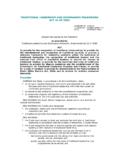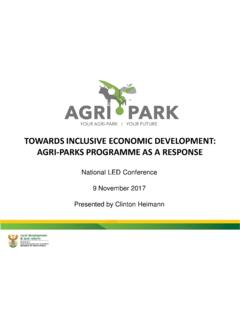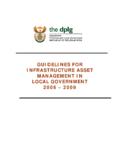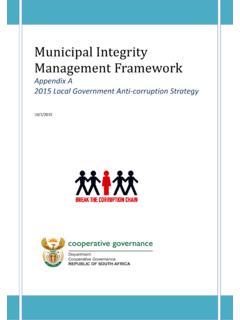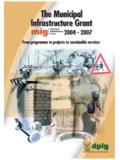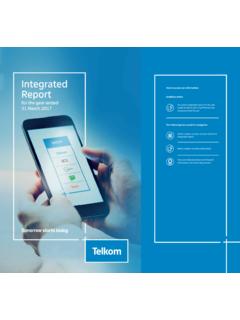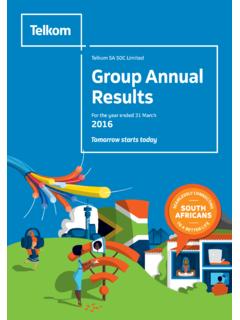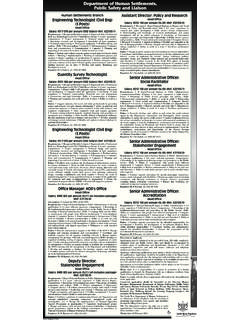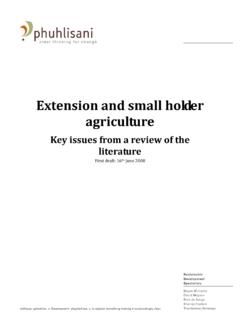Transcription of The Role and Significance of State Owned …
1 The Role and Significance of State Owned Enterprises, Public Entities and other Public Bodies in the Promotion of Urban Growth and Development in South Africa Prepared for the IUDF Panel of Experts August2013 Submitted by: Wendy Ovens and Associates 1 Table of Contents 1. Introduction .. 3 What are State Owned enterprises .. 4 State Owned enterprises and urban planning and development .. 5 Broad challenges with soes identified in the national Development plan .. 9 Purpose of this report .. 9 2. Overview of the Legal Framework guiding SOE participation in urban growth and development .. 11 Land and Housing the Management of Non-core Land .. 11 The Transport Sector .. 18 The Energy Sector.
2 20 The Water Sector .. 21 The Communication sector .. 24 3. Land and housing .. 27 Introduction .. 27 Current policy on the sale of non-core SOE land .. 29 Methods for determining Market Related Price .. 31 Access to Non-core property and the Challenges for integrated urban planning, growth and development .. 32 Possible solutions .. 35 4. Transportation .. 36 Introduction .. 36 Institutional issues .. 36 Challenges for integrated urban planning, growth and development .. 38 METRORAIL the underutilised metropolitan mass transit resource .. 39 Possible solutions .. 54 5. Energy .. 56 Introduction .. 56 2 Institutional issues .. 57 Challenges for integrated urban planning, growth and development .. 59 Possible solutions .. 59 7.
3 Water .. 61 Introduction .. 61 Institutional issues .. 62 Challenges for integrated urban planning, growth and development .. 65 Possible solutions .. 65 8. Communication .. 67 Introduction .. 67 Institutional issues .. 67 Challenges for integrated urban planning, growth and development .. 70 Possible solutions .. 71 9. What needs to change to promote urban development .. 72 Overview of current challenges .. 72 Possible solutions .. 72 10. Conclusion and recommendations .. 74 Bibliography .. 75 Appendix ** .. 77 3 1. INTRODUCTION The National Development Plan (NDP) points out that although cities are generally more resource efficient than scattered settlements, their concentration requires the development of large sources of energy and water and good transport connections which can place strains on the surrounding natural environment.
4 If this is not resolved, cities face varying degrees of water stress, food insecurity and power shortages (NDP, 2013).The NDP s description of urban futures for South Africa indicates the following1: The ways in which goods are produced, transported and consumed must be progressively greened. South African towns and cities must keep up with international innovation in technology, transport and energy production, while local urban innovation systems should be incentivised. Ageing urban infrastructures must be refurbished and core infrastructure like roads, transit, sewers and utilities should be properly maintained. There must be a transition to sustainable infrastructure delivery.
5 Public transport investment should be used for the spatial transformation of towns and cities. New urban development and infrastructure investments should be focused around corridors of mass transit and around existing and emergent economic nodes, applying internationally accepted principles of transit- oriented development. The major concentrations of urban poor should be spatially linked into the mainstream of city life through investments in transport infrastructure and the connecting corridors of development. Recommendations include containing urban sprawl which may require implementing inclusionary housing policies, using State - Owned land for affordable housing.
6 State - Owned enterprises (SOEs) play a major role in most of the above. 1 NDP, 2013 4 WHAT ARE State Owned ENTERPRISES State - Owned enterprises (or public entities) are independent bodies partially or wholly Owned by government. They perform specific functions and operate in accordance with a particular Act. In South Africa, in line with international trends, corporatization, the transformation of State assets or agencies into State - Owned corporations, was introduced in some sectors to promote more effective and efficient service delivery particularly following the democraticelection in , using public authorities rather than full privatization is seen as taking advantage of private-sector efficiencies while maintaining public accountability.
7 When examining the list of national entities in South Africa, it is evident that many have a direct impact on urban growth and development. These may be broadly clustered into the following categories, illustrated in the diagram below: Power generation transmission and distribution ICT Transport Major land holders Providers of development support Figure 1: Categories of SOEs which influence urban growth and development 5 State Owned ENTERPRISES AND URBAN PLANNING AND DEVELOPMENT State Owned enterprises (SOEs) are now important stakeholders and contributors toward supporting and promoting urban growth and development. Firstly, as major owners of large tracts of well-located land, SOEs have significant power in shaping the urban landscape.
8 This was illustrated in research conducted on land use management in five large urban centres which noted the following: In addition to the complexities of urban land use management competencies falling across the departments and spheres of government as mentioned above, every city pointed to the frustration of not having informed access to the land asset base of other spheres of government, particularly in addressing the needs of the poor. In many cases competition and conflict between government was identified as the single biggest barrier to finding affordable well located land for the poor. The highest levels of frustration occurred with respect to State Owned enterprise land (SOE), as not only were there issues of non-cooperation but also 6 the SOE are driven by imperatives of market costing that mitigate against the effective transformatory use of their land for the poor.
9 2 Secondly, a number of SOEs also provide highly significant structuring elements which may influence development patterns within the city such as transportation networks, bulk infrastructure, energy and ICT infrastructure. Examples include Eskom, Telkom, PRASA, Portnet and Petronet. Thirdly, organisations such as Transnet and PRASA perform an important function in terms of improving urban efficiencies through the provision of mass public transport systems. Given the extent of their influence, effective and efficient planning thus becomes essential for managing coherent urban growth and development. Figure 2: SOEs which impact urban growth and development The Development Facilitation Act (DFA) and the more recent Spatial Planning and Land Use Management Bill (SPLUMB), along with the associated guidelines, provide the necessary guidance in this regard.
10 Principles generally relate to the need for promoting integration, optimising the proximity between residential and employment opportunities, preventing urban sprawl, optimising existing infrastructure, ensuring environmental sustainability etc. The table below takes the Section 3c DFA principles which require that policy, administrative practice and laws should promote efficient and integrated development, and relates them to requirements and tothe SOEsresponsible. Table 1: Linking the DFA principles and SOEs Summarised DFA Principle Principle Requirement Contributing or affected SOE (i) Integration of the social, economic, institutional and physical aspects of land Effective and efficient transport networks, systems and services Transport Local Context Transnet Passenger Rail Agency of South 2 Parnell et al, 2006 7 Summarised DFA Principle Principle Requirement Contributing or affected SOE development African (PRASA) South African National Road Agency (SANRAL) (ii)
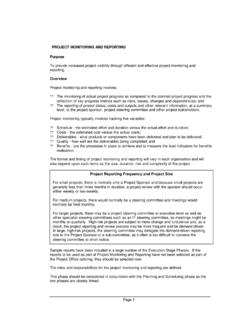
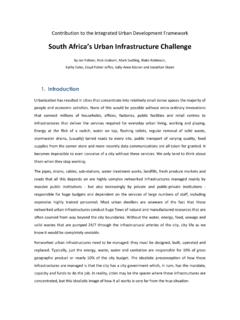
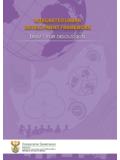
![Disaster Management Act [No. 57 of 2002]](/cache/preview/e/5/d/2/b/3/6/7/thumb-e5d2b36743b64ebe9204d7e874f734ad.jpg)
